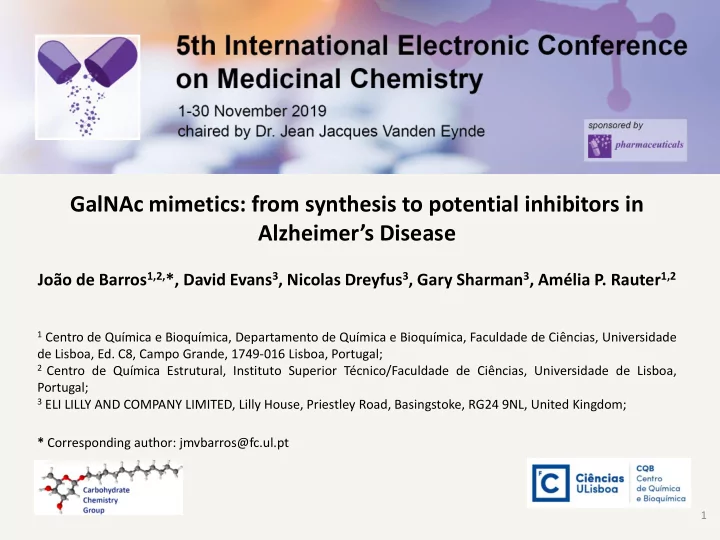

GalNAc mimetics: from synthesis to potential inhibitors in Alzheimer’s Disease João de Barros 1,2, *, David Evans 3 , Nicolas Dreyfus 3 , Gary Sharman 3 , Amélia P. Rauter 1,2 1 Centro de Química e Bioquímica, Departamento de Química e Bioquímica, Faculdade de Ciências, Universidade de Lisboa, Ed. C8, Campo Grande, 1749-016 Lisboa, Portugal; 2 Centro de Química Estrutural, Instituto Superior Técnico/Faculdade de Ciências, Universidade de Lisboa, Portugal; 3 ELI LILLY AND COMPANY LIMITED, Lilly House, Priestley Road, Basingstoke, RG24 9NL, United Kingdom; * Corresponding author: jmvbarros@fc.ul.pt 1
GalNAc mimetics: from synthesis to potential inhibitors in Alzheimer’s Disease Alzheimer´s Disease reality: PrP – A β affinity Hypothesis Prion protein - A β oligomers - GalNAc mimetics 2
Abstract: N -acetylgalactosamine(GalNAc) belongs to the group of 2-amino-2-deoxysugars which are found in a wide range of biological structures playing a role in in cell-cell interaction and receptor induced cell signaling. Alzheimer’s disease (AD) is a protein misfolding pathology, causing dementia in over 40 million people worldwide. Cellular prion protein (PrP) has a high-affinity binding with amyloid β (Aβ) oligomers, the most toxic species in Alzheimer’s pathology. It has been demonstrated that O -glycosylated GalNAc, attached to Ser/Thr side chain of PrP via an α -glycosidic linkage, promotes the inhibition of amyloidogenesis in AD. In this context, we have synthesized new GalNAc mimetics, with additional contacts in the GalNAc core structure, to improve the interactions with the prion peptide and to investigate the binding affinity with Aβ 1-42 . The study of the intermolecular interactions of the new chemical structures and Aβ 1-42 oligomers was investigated by NMR methods, namely saturation transfer difference NMR (STD-NMR) and 19 Fluorine NMR (F-NMR) protocols. In this communication, synthetic approaches to the GalNAc mimetics will be presented and interaction results regarding C2 substitution and anomeric heteroatoms, such as O, S and Se with Aβ 1-42 oligomers will be discussed. Keywords: Alzheimer’s disease; GalNAc; A β oligomers. 3
Introduction Alzheimer’s disease (AD) Protein misfolding pathology Dementia in 40 million people worldwide
Introduction An α -glycosidic linkage to serine of a prion protein (PrP) Ser Ser Ser S135- α -GalNAc S135- α -GlcNAc S135- α -Gal Inhibition of amyloidogenesis Alzheimer’s disease (AD ) 1 1 C. Lin, E. Chen, L. Lee, R. Hsu, F. Luh, L. Yang, C. Chou, L. Huang, C. Lin, R. Chen, Carbohydr. Res . 2014, 387, 46-53.
Introduction Cellu Ce llula lar prio rion protein in (P (PrP rP) High-affinity binding Receptor capable to mediate the neurotoxic effect of Aβ oligomers 2 Amyloid β (Aβ) oligomers Considered responsible for synaptic and cognitive dysfunction as well as neurodegenerative effect in AD 2 Laurén J, Gimbel DA, Nygaard HB, Gilbert JW, Strittmatter SM. Cellular prion protein mediates impairment of synaptic plasticity by amyloid-beta oligomers. Nature 2009; 457:1128-32.
Results and discussion Synthesis: SePh 7
Results and discussion Synthesis: SePh 8
Results and discussion Synthesis: OPh a) PhOH, I 2 /DDQ, dioxane/toluene, r.t., overnight, 67%; b) RCOCl, PPh 3 , DCM ,r.t., overnight; 61 %; c) NaOMe, MeOH, r.t., 1h, 93%. 9
Results and discussion Synthesis: SPh a) RCOCl, PPh 3 , DCM ,r.t., overnight; 34 %; b) NaOMe, MeOH, r.t., 1h, 97%. 10
Results and discussion Synthesis 11
Results and discussion STD-NMR Compounds 1, 2 and 3 interactions with A β 1-42 oligomers most active similar to not active similar to not active 12
Results and discussion 19 F-NMR Compound 1 interactions with A β 1-42 oligomers – Positive result Blue – absence of A β Red – presence of A β 13
Results and discussion Toxicity Experiments MTT experiments revealed to be non toxic > 75 % cell viability (50 μ M) 14
Conclusions New GalNAc mimetics - Synthetic route aiming C2 N -functionalization; - Anomeric substitution with stereochemical control. A β 1-42 interaction (STD-NMR; 19 F-NMR) and toxicity results STD – NMR and 19 F-NMR: - require the presence of selenium atom, at the anomeric position; - selenogalactoside interact with Aβ 1-42 oligomers, opening the possibility to inhibit the PrP- Aβ bindin g; Compounds toxicity: - selenoglactoside (active compound) is not toxic. 15
Acknowledgments The European Union for the support of the project entitled “Diagnostic and Drug Discovery Initiative for Alzheimer’s Diseases” (D3i4AD), FP7 -PEOPLE-2013-IAPP, GA 612347. • Prof. Amélia Rauter (FCUL/ Universidade de Lisboa) • Mr. Nicolas Dreyfus (Eli Lilly) • Dr. Gary Sharman (Eli Lilly) • Dr. David Evans (Eli Lilly) • Dr. Christoffer Bundgaard (Eli Lilly) • Dr. Marta de Matos (FCUL/ Universidade de Lisboa) • Mr. James Grayson (Sheffield University/ Eli Lilly)
Recommend
More recommend